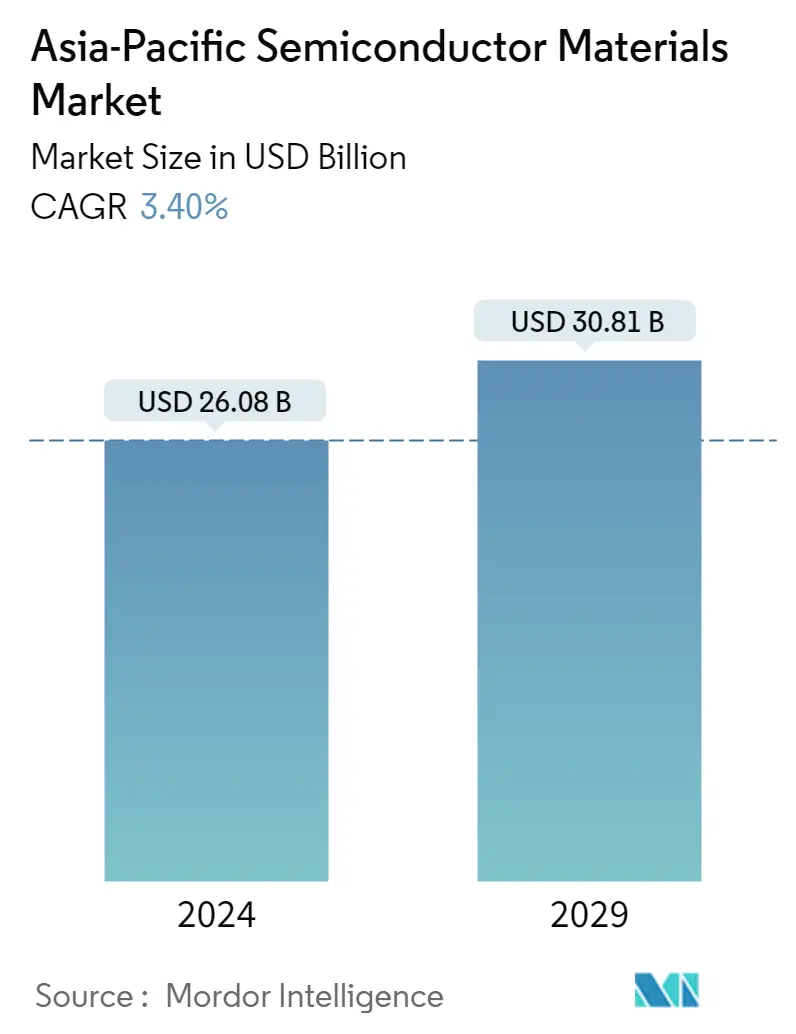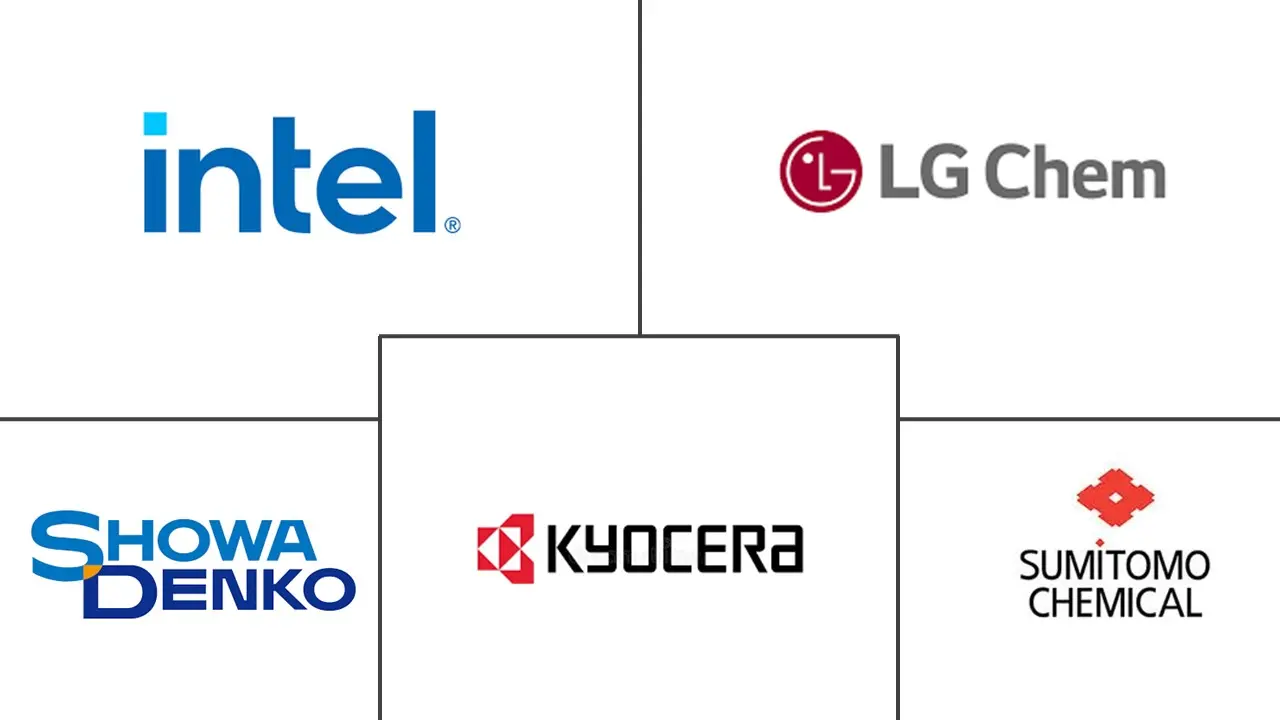Market Size of Asia-Pacific Semiconductor Materials Industry

| Study Period | 2019 - 2029 |
| Base Year For Estimation | 2023 |
| Market Size (2024) | USD 26.08 Billion |
| Market Size (2029) | USD 30.81 Billion |
| CAGR (2024 - 2029) | 3.40 % |
| Market Concentration | High |
Major Players*Disclaimer: Major Players sorted in no particular order |
APAC Semiconductor Materials Market Analysis
The Asia-Pacific Semiconductor Materials Market size is estimated at USD 26.08 billion in 2024, and is expected to reach USD 30.81 billion by 2029, growing at a CAGR of 3.40% during the forecast period (2024-2029).
This may be attributed to its high electron mobility, wide temperature range, and low energy consumption. Further, the technical development of electronic devices and the rising need for semiconductor packing materials are expected to drive market growth.
- By utilizing materials such as silicon (Si), germanium (Ge), and gallium arsenide (GaAs), electronics manufacturers have been able to replace traditional thermionic devices that made electronic items heavy and non-portable. Since the inception of semiconductor elements, there has been a high degree of miniaturization, making electronic equipment more compact and mobile. Silicon is considered the best among all the semiconductor elements available in the current market scenario.
- The semiconductor industry is dominated by a few countries, mainly the U.S., Taiwan, South Korea, Japan, China, and Europe. As per SIA (U.S. Semiconductor Industry Association), 57% of the semiconductor materials, 56% of wafer fabrications, and 70% of the memory come from Asian countries. China has been investing strategically to strengthen its semiconductor industry and has been able to maintain strong supply chain control. Such factors increase the demand for semiconductor materials in the region.
- The spike in demand for consumer electronics is one of the primary reasons driving the growth of the worldwide semiconductor materials market. Furthermore, technological developments and the adoption of novel technologies such as artificial intelligence and blockchain propel the semiconductor market forward.
- According to the India Electronics and Semiconductor Association, India is anticipated to consume around USD 27 billion worth of semiconductors in 2022 and USD 70 billion by 2026. The semiconductor market will also see an increase in demand; as 5G connections are implemented and used, the performance of 5G will directly improve the production of smart products. Furthermore, Internet of Things (IoT) devices may support multiple connections simultaneously while increasing speed, latency, reliability, and battery consumption.
- The semiconductor materials market is witnessing challenges such as the costs involved in maintaining optimized levels of physical, electrical, and thermal constraints, which is difficult. Moreover, recycling smaller semiconductor materials is financially problematic, given the small amount of material reclaimed from individual products, such as smartphones.
- The COVID-19 pandemic has halted the manufacturing of several items in the semiconductor production equipment industry, owing to lockdown across the region. Lockdown measures resulted into supply chain disruption and affected catering to the demand for the consumer electronic gadgets, which had a global impact on the semiconductor sector.
APAC Semiconductor Materials Industry Segmentation
The Asia-Pacific semiconductor materials market is segmented by type of material (silicon carbide, gallium manganese arsenide, copper indium gallium selenide, molybdenum disulfide, and bismuth telluride), application (fabrication (process chemicals, photomasks, electronic gases, photoresists ancillaries, sputtering targets, silicon, and other fabrication materials)), packaging (substrates, lead frames, ceramic packages, bonding wire, encapsulation resins, die attach materials, and other packaging types), end-user industry (consumer electronics, telecommunication, manufacturing, automotive, energy and utility, and other end-user industries) and geography (Taiwan, South Korea, China, Japan, and Rest of Asia-Pacific). The market sizes and forecasts are provided in terms of value (USD million) for all the above segments.
| By Material | |
| Silicon Carbide (SiC) | |
| Gallium Manganese Arsenide (GaAs) | |
| Copper Indium Gallium Selenide (CIGS) | |
| Molybdenum Disulfide (MoS) | |
| Bismuth Telluride (Bi2Te3) |
| By Application | |||||||||
| |||||||||
|
| By End-user Industry | |
| Consumer Electronics | |
| Telecommunication | |
| Manufacturing | |
| Automotive | |
| Energy and Utility | |
| Other End-User Industries |
| By Country | |
| Taiwan | |
| South Korea | |
| China | |
| Japan | |
| Rest of Asia-Pacific |
Asia-Pacific Semiconductor Materials Market Size Summary
The Asia-Pacific semiconductor materials market is poised for significant growth, driven by the increasing demand for consumer electronics and advancements in technology. The region's market is characterized by the use of materials such as silicon, germanium, and gallium arsenide, which have enabled the miniaturization and enhancement of electronic devices. Silicon, in particular, remains a dominant choice due to its favorable properties, including high electron mobility and low energy consumption. The market is further bolstered by strategic investments from countries like China and India, aiming to strengthen their semiconductor industries and supply chain control. The rise of technologies such as artificial intelligence, blockchain, and the implementation of 5G are also contributing to the market's expansion, as they require advanced semiconductor materials for improved performance and connectivity.
The competitive landscape of the Asia-Pacific semiconductor materials market is marked by the presence of major players like Showa Denko Materials Co. Ltd, LG Chem, and Kyocera Corporation, who are actively engaged in product innovation and capacity expansion to meet the growing demand. These companies are focusing on developing new technologies and materials, such as gallium nitride and silicon carbide, which offer enhanced performance for power electronic devices. The market is also witnessing challenges, including the high costs of maintaining optimal physical and thermal constraints and the complexities of recycling smaller semiconductor materials. Despite these challenges, the market is expected to continue its growth trajectory, supported by government initiatives and industry collaborations aimed at establishing a robust semiconductor ecosystem in the region.
Asia-Pacific Semiconductor Materials Market Size - Table of Contents
-
1. MARKET INSIGHTS
-
1.1 Market Overview
-
1.2 Industry Attractiveness - Porter's Five Forces Analysis
-
1.2.1 Bargaining Power of Suppliers
-
1.2.2 Bargaining Power of Consumers
-
1.2.3 Threat of New Entrants
-
1.2.4 Intensity of Competitive Rivalry
-
1.2.5 Threat of Substitute Products
-
-
1.3 Assessment of COVID-19 Impact on the Market
-
-
2. MARKET SEGMENTATION
-
2.1 By Material
-
2.1.1 Silicon Carbide (SiC)
-
2.1.2 Gallium Manganese Arsenide (GaAs)
-
2.1.3 Copper Indium Gallium Selenide (CIGS)
-
2.1.4 Molybdenum Disulfide (MoS)
-
2.1.5 Bismuth Telluride (Bi2Te3)
-
-
2.2 By Application
-
2.2.1 Fabrication
-
2.2.1.1 Process Chemicals
-
2.2.1.2 Photomasks
-
2.2.1.3 Electronic Gases
-
2.2.1.4 Photoresists Ancilliaries
-
2.2.1.5 Sputtering Targets
-
2.2.1.6 Silicon
-
2.2.1.7 Other Fabrication Materials
-
-
2.2.2 Packaging
-
2.2.2.1 Substrates
-
2.2.2.2 Lead Frames
-
2.2.2.3 Ceramic Packages
-
2.2.2.4 Bonding Wire
-
2.2.2.5 Encapsulation Resins (Liquid)
-
2.2.2.6 Die Attach Materials
-
2.2.2.7 Other Packaging Materials
-
-
-
2.3 By End-user Industry
-
2.3.1 Consumer Electronics
-
2.3.2 Telecommunication
-
2.3.3 Manufacturing
-
2.3.4 Automotive
-
2.3.5 Energy and Utility
-
2.3.6 Other End-User Industries
-
-
2.4 By Country
-
2.4.1 Taiwan
-
2.4.2 South Korea
-
2.4.3 China
-
2.4.4 Japan
-
2.4.5 Rest of Asia-Pacific
-
-
Asia-Pacific Semiconductor Materials Market Size FAQs
How big is the Asia-Pacific Semiconductor Materials Market?
The Asia-Pacific Semiconductor Materials Market size is expected to reach USD 26.08 billion in 2024 and grow at a CAGR of 3.40% to reach USD 30.81 billion by 2029.
What is the current Asia-Pacific Semiconductor Materials Market size?
In 2024, the Asia-Pacific Semiconductor Materials Market size is expected to reach USD 26.08 billion.


